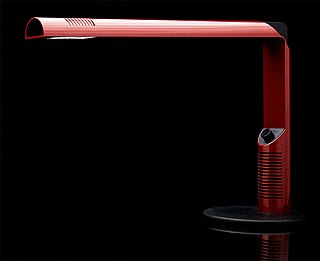Related Research Articles

Josef Müller-Brockmann was a Swiss graphic designer, author, and educator, he was a Principal at Muller-Brockmann & Co. design firm. He was a pioneer of the International Typographic Style. Müller-Brockmann is recognized for his simple designs and his clean use of typography, shapes and colors which inspire many graphic designers in the 21st century.
Robert Brunner is an American industrial designer. Brunner was the Director of Industrial Design for Apple Computer from 1989 to 1996, and is a founder and current partner at Ammunition Design Group.

Paola Antonelli is an Italian architect, curator, author, editor, and educator. Antonelli is the Senior Curator of Architecture and Design at the Museum of Modern Art (MoMA), New York, where she also serves as the founding Director of Research and Development. She has been described as "one of the 25 most incisive design visionaries in the world" by TIME magazine.

Brionvega is an Italian electronics company that is known for manufacturing futuristic television sets and audio equipment, its contributions to post-second world war technological and social advancement in Italian industry, collaborations with well known industrial designers and architects, and its impact on the aesthetics of 1960s Italian design.

Alexander Girard, affectionately known as Sandro, was an architect, interior designer, furniture designer, industrial designer, and a textile designer.
Ikko Tanaka was a Japanese graphic designer. Tanaka is widely recognized for his prolific body of interdisciplinary work, which includes graphic identity and visual matter for brands and corporations including Seibu Department Stores, Mazda, Issey Miyake, Hanae Mori, and Expo 85. He is credited with developing the foundational graphic identity for lifestyle brand Muji, emphasizing the "no brand" quality of their products through unadorned, charming line drawings paired with straightforward slogans. His use of bold, polychromatic geometries and his harnessing of the dynamic visual potential of typography are undergirded by a sensitivity towards traditional Japanese aesthetics. Though keenly sensitive to historical precedents and established conventions, Tanaka nevertheless maintained a degree of playfulness in his work, manipulating color, scale, and form to reconfigure familiar iconographies into fresh and accessible visual representations.
Hans Krondahl was a Swedish painter, tapestry weaver, textile artist and textile designer. He studied painting and textile art at Konstfack, in Stockholm from 1955 to 1960.
Paul Winthrop McCobb was an American modern furniture designer, textile designer, painter, and industrial designer.
Mary Ping is an American fashion designer based in New York City. She is best known for her conceptual label "Slow and Steady Wins the Race", although she has also designed under her own label.

Dorothy Wright Liebes was an American textile designer and weaver renowned for her innovative, custom-designed modern fabrics for architects and interior designers. She was known as "the mother of modern weaving".

Gianfranco Frattini was an Italian architect and designer. He is a member of the generation that created the Italian design movement in the late 1950s through the 1960s and is considered to have played a major role in shaping it.
Edra s.p.a. is an Italian manufacturing company specialized in the creation of innovative designer furniture.
Marianne Strengell was an influential Finnish-American Modernist textile designer in the twentieth century. Strengell was a professor at Cranbrook Academy of Art from 1937 to 1942, and she served as department head from 1942 to 1962. She was able to translate hand-woven patterns for mechanized production, and pioneered the use of synthetic fibers.
Eszter Haraszty was a Hungarian-born designer best known for her work as head of the textiles department at Knoll.

Pierre Armand Kleykamp was a Modern furniture, interior, graphic, textile, product designer and teacher. Born in Belgium of Dutch nationality, he became a U.S. citizen in 1954. His clients included KLM, Holland-American Lines, Aetna Life Insurance, the United Nations. He supplied furniture to the Goed Wonen Groep and crafted several pieces for the interior of Schiphol Airport's International Departure Hall.

The Good Design exhibition series was an industrial design program organized by the Museum of Modern Art (MoMA) in New York, in cooperation with the Merchandise Mart in Chicago, held between 1950 and 1955. No awards were granted to designers whose work was put on view in these exhibitions, despite misinformation suggesting otherwise.
Evelyn Anselevicius was an American textile artist best known for her large-scale, geometric woven tapestries, often created using Mexican techniques and traditions.

Maria Benktzon is a Swedish designer, she is known for industrial design with human factors. She is a co-founder of Ergonomi Design Gruppen which later became Veryday, an industrial design consultancy located in Stockholm.

Smart Design is a design consultancy based in New York City. Smart was founded in 1980 by industrial designers Davin Stowell, Tom Dair, Tucker Viemeister, and Tamara Thomsen, with Stowell serving as CEO. The firm has been a prominent presence in the design industry since the late 1980s, as design competency increasingly came to be seen as "key to industrial competitiveness".

Heller is an American company founded in 1971 that makes and sells indoor/outdoor furniture and accessories. It is headquartered in Westport, Connecticut, United States. Its founder, Alan Heller, invited well-known architects and designers including Mario Bellini, Frank Gehry, and Lella and Massimo Vignelli to create products for the company.
References
- ↑ "Joel Robinson | MoMA". The Museum of Modern Art. Retrieved February 6, 2021.
- ↑ Gardner, Andrew (June 5, 2019). ""Lily-White": Joel Robinson and Black Identity in MoMA's Good Design Program". post. MoMA. Retrieved February 6, 2021.
- ↑ "Joel Robinson | MoMA". The Museum of Modern Art. Retrieved February 6, 2021.
- ↑ "Joel Robinson Combines Talents In Newest Job". The New York Age. February 27, 1954. p. 12. Retrieved October 24, 2022.
- 1 2 “Fabric Designer,” Ebony vol. 7 no. 7 (May 1952): 112-116.
- ↑ Gardner, Andrew (June 5, 2019). ""Lily-White": Joel Robinson and Black Identity in MoMA's Good Design Program". post. MoMA. Retrieved February 6, 2021.
- ↑ “Wealthy Bachelors,” Ebony vol. 7 no. 12 (October 1952): 31-36.
- ↑ “Marriage Through Ebony,” Ebony vol. 9 no. 9 (July 1954): 6.
- ↑ "A. Joel Robinson | People | Collection of Cooper Hewitt, Smithsonian Design Museum". collection.cooperhewitt.org. Retrieved February 6, 2021.
- ↑ "Ovals, Joel Robinson; Manufacturer: L. Anton Maix, Inc. ^ Minneapolis Institute of Art". collections.artsmia.org. Retrieved February 6, 2021.
- ↑ "Joel Robinson | MoMA". The Museum of Modern Art. Retrieved February 6, 2021.
- ↑ "Artist: Adolph Joel Robinson". The Cleveland Museum of Art. Retrieved October 24, 2022.
- ↑ "Robinson, Joel | V&A Explore The Collections". Victoria and Albert Museum: Explore the Collections. Retrieved October 9, 2022.